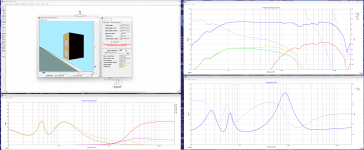Hi, I am going to college this year and as my long-term graduation project I am designing a 2.5 way speaker. I am a complete newbie and this is actually my first "bigger" project since I already built two simple bluetooth speakers few years back. This time a looked up and studied a lot of information, read tons of guides and tried to make it as good as possible. Yet here I am with a request for you experienced speaker builders. Down below I will post as much information about the project itself can you please take a look at it and tell me your opinion and ideas, how to make it even better? As I said I am a beginner and dont have a clue what is wrong and what is not.
Drivers
I am using 2 Dayton Audio RS180-8 7" woofers and RST28F-4 1-1/8" tweeter. I will connect them to 200W 4 ohm amplifier but I don't plan to listen at max SPL.
Enclosure (45x36x30cm - HxWxD, 18mm thick plywood)
I simulated it in Unibox and decided to go with ported 35,4L box tuned to 47hz. It will be ported using 2 76mm AEROPORT ports. I kept in mind baffle and edge diffraction and decided to mount all the drivers in line with the baffle later when building the speaker. To avoid speaker lobing I will mount each driver different further from the edge of the baffle. Also I calculated my crossover frequency wavelenght to mount the drivers within this range. I will attach all the screenshots and graphs from Unibox as well as my poor sketch of the enclosure.
Simulated measurements manipulation
I followed Paul Carmody's "Designing speakers with simulated measurements" guide and used Jeff Bagby's Response Modeler application. I modeled the impedance of the woofer and applied box simulation to its .FRD file. Then I simulated for baffle diffraction and loss and extraced the minimum phase. For the tweeter, I only simulated for baffle diffraction and loss and extraced the minimum phase. I will attach those manipulated files here as well.
Crossover
This is the part I don't know if I did right. I designed it XSim and tried to make the frequency response as flat as possible. Also tried to keep the impedance flat which I did not really achieved in my opinion - especially the tweeter's peak. Crossover frequency is around 1750hz.
And that's about it, I hope I can get some feedback and help on making it even better. If you have questions I will answer them as soon as possible. Thank you so much guys!
Drivers
I am using 2 Dayton Audio RS180-8 7" woofers and RST28F-4 1-1/8" tweeter. I will connect them to 200W 4 ohm amplifier but I don't plan to listen at max SPL.
Enclosure (45x36x30cm - HxWxD, 18mm thick plywood)
I simulated it in Unibox and decided to go with ported 35,4L box tuned to 47hz. It will be ported using 2 76mm AEROPORT ports. I kept in mind baffle and edge diffraction and decided to mount all the drivers in line with the baffle later when building the speaker. To avoid speaker lobing I will mount each driver different further from the edge of the baffle. Also I calculated my crossover frequency wavelenght to mount the drivers within this range. I will attach all the screenshots and graphs from Unibox as well as my poor sketch of the enclosure.
Simulated measurements manipulation
I followed Paul Carmody's "Designing speakers with simulated measurements" guide and used Jeff Bagby's Response Modeler application. I modeled the impedance of the woofer and applied box simulation to its .FRD file. Then I simulated for baffle diffraction and loss and extraced the minimum phase. For the tweeter, I only simulated for baffle diffraction and loss and extraced the minimum phase. I will attach those manipulated files here as well.
Crossover
This is the part I don't know if I did right. I designed it XSim and tried to make the frequency response as flat as possible. Also tried to keep the impedance flat which I did not really achieved in my opinion - especially the tweeter's peak. Crossover frequency is around 1750hz.
And that's about it, I hope I can get some feedback and help on making it even better. If you have questions I will answer them as soon as possible. Thank you so much guys!
Attachments
-
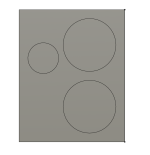 LFX_B1 Fusion_Screenshot2.png14.5 KB · Views: 117
LFX_B1 Fusion_Screenshot2.png14.5 KB · Views: 117 -
RS180_Sim_Minphase.frd13.5 KB · Views: 56
-
RS180_Sim_Minphase.zma13.2 KB · Views: 55
-
RST28F_Sim_Minphase.frd13.5 KB · Views: 53
-
RST28F_Minphase.zma8.6 KB · Views: 52
-
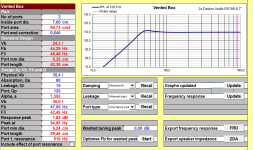 LFX_B1 Unibox_Screenshot1.png27.6 KB · Views: 115
LFX_B1 Unibox_Screenshot1.png27.6 KB · Views: 115 -
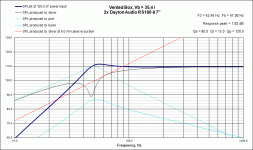 LFX_B1 Unibox_Screenshot2.gif33.1 KB · Views: 114
LFX_B1 Unibox_Screenshot2.gif33.1 KB · Views: 114 -
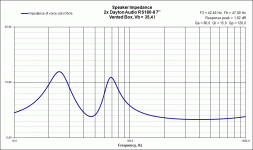 LFX_B1 Unibox_Screenshot4.gif22.6 KB · Views: 105
LFX_B1 Unibox_Screenshot4.gif22.6 KB · Views: 105 -
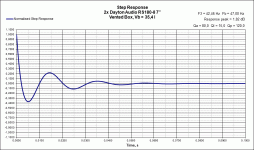 LFX_B1 Unibox_Screenshot3.gif26.4 KB · Views: 144
LFX_B1 Unibox_Screenshot3.gif26.4 KB · Views: 144 -
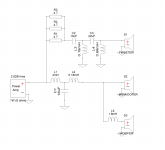 LFX_B1 XSim_Screenshot1.png15.7 KB · Views: 143
LFX_B1 XSim_Screenshot1.png15.7 KB · Views: 143 -
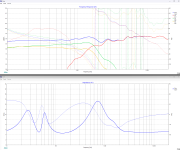 LFX_B1 XSim_Screenshot2.png47.3 KB · Views: 146
LFX_B1 XSim_Screenshot2.png47.3 KB · Views: 146 -
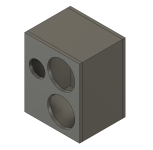 LFX_B1 Fusion_Screenshot1.png48.8 KB · Views: 118
LFX_B1 Fusion_Screenshot1.png48.8 KB · Views: 118
Might be a little more practical to resort to dsp based crossover filter.
It is important to listen to whatever filter solution you find worth employing.
That you will be able to do comfortably with dsp. The learning process
is already complicated enough that you do not need to worry about
stashing passive filter components. It's reserved for the nutters as myself,
for instance.
It is important to listen to whatever filter solution you find worth employing.
That you will be able to do comfortably with dsp. The learning process
is already complicated enough that you do not need to worry about
stashing passive filter components. It's reserved for the nutters as myself,
for instance.
If you're doing a .5 way, go TMM in a vertical line with a slight offset of the tweeter on top......if not, you're gonna have some strange polar patterns/power response. At that point, given a smaller footprint, i can't see why a stand mount....just floorstand it with bracing and disperse the enclosure resonance out farther.
@mayhem13
I understand what you are trying to say. I forgot to mention it but the thing is that the speaker will be combined mono. It's not designed to be build in pair. I am trying to make it powered by external amplifier with a summing amplifier inside the speaker. Later implement the amp inside the chassis alongside with bluetooth connectivity. Do you think the polar patterns and off axis response will be horrible? Anyways thank you for your answer.
I understand what you are trying to say. I forgot to mention it but the thing is that the speaker will be combined mono. It's not designed to be build in pair. I am trying to make it powered by external amplifier with a summing amplifier inside the speaker. Later implement the amp inside the chassis alongside with bluetooth connectivity. Do you think the polar patterns and off axis response will be horrible? Anyways thank you for your answer.
If you're using the newer version of XSim, it will do basic modeling of off-axis behavior. That stuff is in the Baffle menu. You need to set the driver sizes and their layout correctly also.Do you think the polar patterns and off axis response will be horrible?
I took a look at it and I must say, wow, it's bad. Well what now? Do I have to redesign it whole or just tweak something? Any tips?
When you say bad. What was it that jumped out at you?
If it was purely the effect of the positions and their horizontal and vertical polars, I guess it has saved you the cost of a cabinet.
If you go for a more traditional vertical aligned 2.5 driver layout, sometimes people aim to have the handover between the two low/mid drivers at the baffle step frequency so possibly a bit of work around that area could prove beneficial.
Maybe within the idea of using a single cabinet for mixed mono, you could bring the tweeter more to the centre line, or rotate the box by 90 degrees and have the tweeter on top with the two woofers mounted such that their centres would make an equilateral triangle with the tweeter centre point.
Please note that I haven't done this myself so i cannot confirm positive results, but for a couple of hours modelling may give you a better set of data. Also I would suggest a look at VituixCad, if you are going to be doing this for a while it may be worth the extra effort to get used to working with it.
Getting nice cabinet modelled responses should help with the implementation of either a passive or active crossover.
If it was purely the effect of the positions and their horizontal and vertical polars, I guess it has saved you the cost of a cabinet.
If you go for a more traditional vertical aligned 2.5 driver layout, sometimes people aim to have the handover between the two low/mid drivers at the baffle step frequency so possibly a bit of work around that area could prove beneficial.
Maybe within the idea of using a single cabinet for mixed mono, you could bring the tweeter more to the centre line, or rotate the box by 90 degrees and have the tweeter on top with the two woofers mounted such that their centres would make an equilateral triangle with the tweeter centre point.
Please note that I haven't done this myself so i cannot confirm positive results, but for a couple of hours modelling may give you a better set of data. Also I would suggest a look at VituixCad, if you are going to be doing this for a while it may be worth the extra effort to get used to working with it.
Getting nice cabinet modelled responses should help with the implementation of either a passive or active crossover.
I am getting a huge drop around 1760hz when +36 degrees and -40 degrees horizontal. Mostly in crossover point in on-axis. In vertical I get a recess of mids and treble.



Just a thought what happens if you change Xover order to third, instead of 4th and maybe set Xover target to 2.5 KHz or thereabouts?
I am not sure the tweeter can handle that, I would expect the response to drop somewhat quicker maybe too much capacitance one the tweeter side, look for other Xovers where people have use that particular tweeter and consider why they did that?
I am not sure the tweeter can handle that, I would expect the response to drop somewhat quicker maybe too much capacitance one the tweeter side, look for other Xovers where people have use that particular tweeter and consider why they did that?
It definitely helped in plus degrees horizonal but in minus degrees it still happened. So I tried just setting the enclosure to vertical line, centered both woofers and did small offest on the tweeter and that fixed the issue of having different off-axis responses. Yet still even after tweaking the crossover a bit the drop still happens when the woofers frequency responses goes down. Is finding another tweeter the best solution or is it just a crossover/enclosure problem?
If you are reasonably happy with a new tweeter response start lessening or removing the woofers inductance.
Even completely to give you a reminder of their cabinet response and allow you to get a feel of how the combination behaves. maybe start with second order and see how that flows.
Also don't be afraid to swap tweeter phase now and again just in case that helps, you may have to alter component values a little because of the change, but it can sometimes give you a workable response.
Even completely to give you a reminder of their cabinet response and allow you to get a feel of how the combination behaves. maybe start with second order and see how that flows.
Also don't be afraid to swap tweeter phase now and again just in case that helps, you may have to alter component values a little because of the change, but it can sometimes give you a workable response.
At its core, some of what you are seeing is just the nature of non-coincident sources with an overlapping range where wavelengths are relatively small compared to the distance between the drivers. This creates a phase difference between the output of the two sources as you move off axis since the distance to each driver is not identical in that case. The crossover typically adds its own phase issues as well. Normal configuration speakers (tweeter aligned vertically above woofer) basically all have problems in vertical off-axis response. You can manipulate the shape of the lobe that is generated with different crossover types and Z-offsets, etc., but it's usually there even in commercial speakers. Designers decide what listening window is acceptable to them, and just do their best to smooth response over that range.is it just a crossover/enclosure problem?
Moving the drivers closer together, using a lower cross point, and using very steep crossovers are some of the ways to improve it. You are already using a tweeter with a pretty low resonance for a standard dome, so switching tweeters won't get you a lot. Normal tweeters also have limited output capabilities at low frequencies, so you can only push a 1 inch-ish tweeter so low if you want reasonable output and distortion. Instead of a dome tweeter, using a wideband driver like a 2- or 3-inch "full range" would let you push the crossover point significantly lower, but will also typically have narrower dispersion at high frequencies.
For horizontal off-axis performance, aligning the drivers vertically takes care of that, as I think you noticed in your later model. That's typically given more weight in designing normal stereo speakers, since it affects imaging. If you have a large woofer, high cross point, etc. you can still get drooping frequency response near the cross point, but that's due to mismatched driver directivity, which is a different consideration.
Last edited:
It's implied in my previous post, but I didn't explicitly say that a midrange with coaxially mounted tweeter can have the same off-axis behavior in any direction (except for minor differences caused by the enclosure). You don't have as many choices for co-ax drivers, but there are a few for home audio and a decent number for car audio. For common co-ax drivers frequency response tends to be uneven at high frequencies, but that typically looks worse on a graph than it sounds.
Yesterday I started working on the enclosure revision. I decided to give the tweeter another chance because it's high sensitivity. Having +6db on 87db/1m parallel woofers narrows down the selection quite a lot (at least on SoundImports.) Also looked at some AMT tweeters from GRS and Dayton but they have to be crossed quite high and that's not possible for my woofer configuration. Really liked the new Dayton Audio AMTHR-4 but it's really over my budget. At the moment I am working on the enclosure design and plan to do all the calculations tommorow. Managed to stay in 35.4 liters with same tuning as previous one and without over-exceeding over excursion and port air speed at max SPL. Followed the suggestions I got here and decided for verical line TMM with slight offset on the tweeter but had to use truncated faceplate due to the crossover point's wavelenght at around 2-2.2kHz.

A 35L volume is a bit too big for that driver.
The blue, dashed lines are a QB3 alignment (20L tuned at 47Hz).
The brown line includes the baffle step loss (panel width 20cm).

The blue, dashed lines are a QB3 alignment (20L tuned at 47Hz).
The brown line includes the baffle step loss (panel width 20cm).
I tried lowering the Vb to around 20 liters, how did you manage to keep air speed low? Having 47hz Fb and one 7,6cm port I get around 23m/s which will be chuffing at low frequencies. Did I understood something wrong?
I apologize for my late response. I completely remodeled the enclosure and splitted it into two separate chambers. One following the recommendation of around 20 liters which I surpassed to almost 26 liters and the second one for the tweeter which is sealed into own enclosure so it does not matter how big it is. I also decided to round up the edges of the baffle by 0.5 inches. The parameters are 52x23x40cm HxWxD while woofers's chamber is 40.2x23x40cm HxWxD. The woofers are kept centered in line and the tweeter has 2cm offset. I also recalculated all the parameters and went with 48hz Fb with two 7cm ports each 34,7cm long. After that I did all the work on the crossover with crossover point at 2200hz and managed quite "good" both on-axis and off-axis frequency response. What do you think?
Attachments
Much prefer the revised cabinet design. Wide front baffles are so 70's and are not sound friendly.
Such blanket statements can confuse a newbie. Some wide baffles speakers can sound very very good, even with the mid and tweeter centralised on the baffle some older monkey coffins were and are regarded well
True I should have been more specific about what it would do to the sound. While wide front baffles were all the rage in the 70's and 80's but they did come at a price and that was reflection issues (especially the centrally mounted ones), making the sound more forward sounding. Some people might like that but as the decades have passed people are now more interested in creating a wider sound stage which is why the industry has mostly transitioned into narrow baffle speakers. On top of other benefits like creating a structure that is less prone to cabinet drone.Such blanket statements can confuse a newbie. Some wide baffles speakers can sound very very good, even with the mid and tweeter centralised on the baffle some older monkey coffins were and are regarded well
- Home
- Loudspeakers
- Multi-Way
- Building my first 2.5 way speaker
